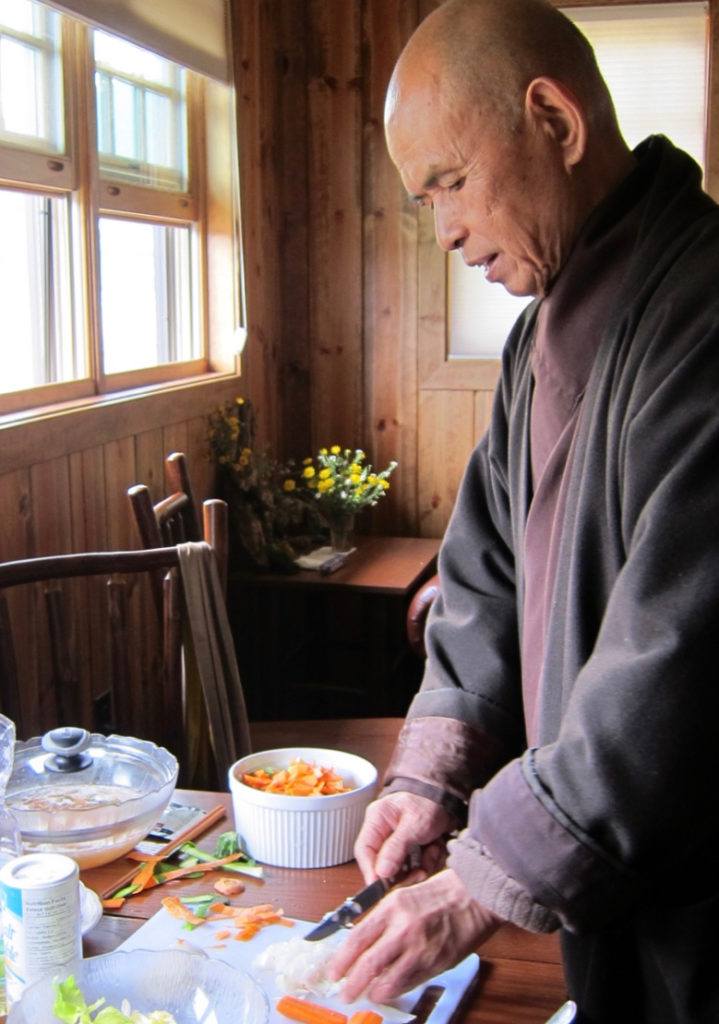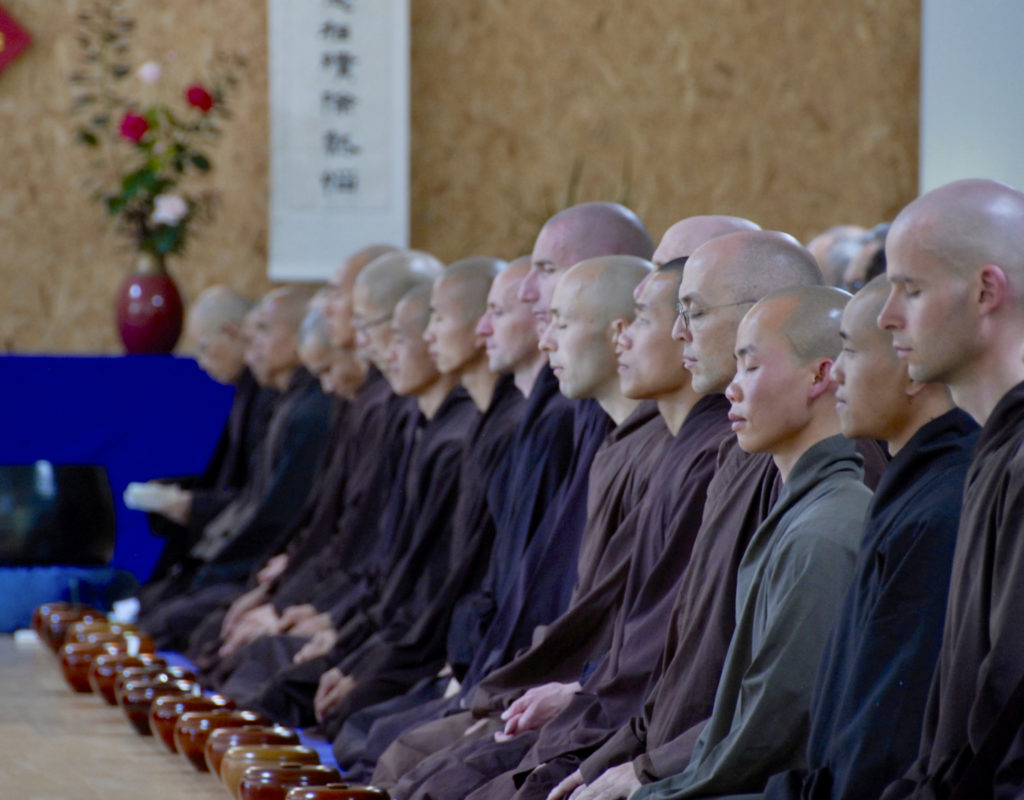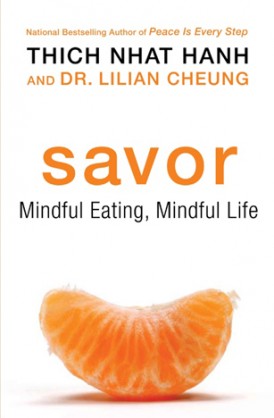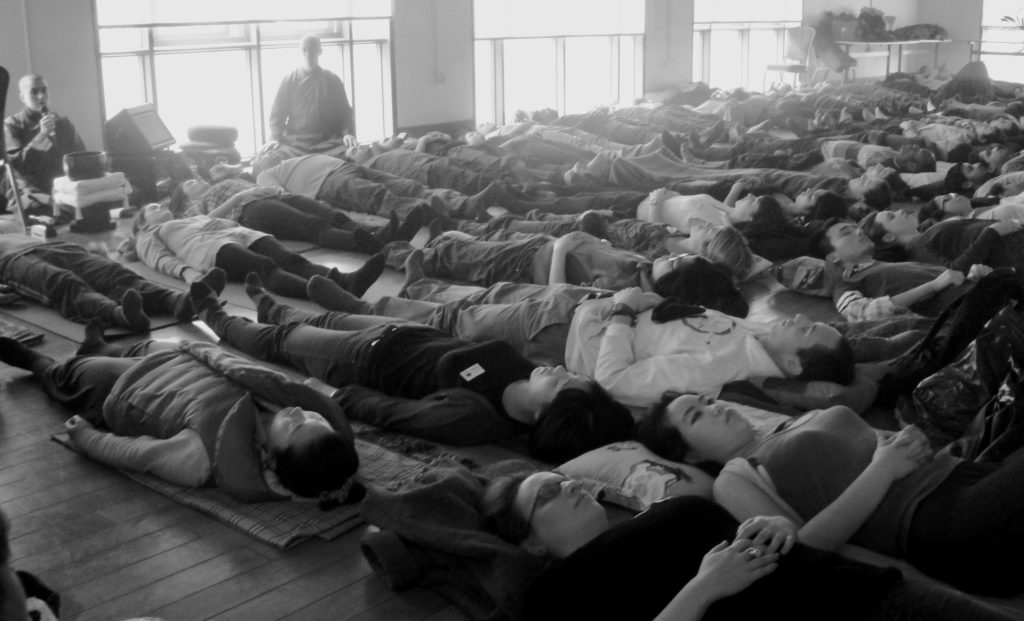Thich Nhat Hanh has been a pioneer bringing mindfulness in the West since the early 1970s, developing new ways to apply ancient wisdom to the challenges of modern life.

Mindfulness is a kind of energy that we generate when we bring our mind back to our body and get in touch with what is going on in the present moment, within us and around us. We become aware of our breathing and come home to our body, fully present for ourselves and whatever we are doing.
The energy of mindfulness helps us touch life deeply throughout the day, whether we’re brushing our teeth, washing the dishes, walking to work, eating a meal, or driving the car. We can be mindful while standing, walking or lying down; while speaking, listening, working, playing and cooking.
Mindfulness is not hard work. It’s very pleasant and relaxing, and we don’t need extra time to do it. There’s an art to finding creative ways to generate the energy of mindfulness, peace, and happiness in everyday life.
And when we practice mindfulness together with others in community, as we do in Plum Village, we generate a powerful collective energy that can help bring healing and transformation to ourselves and the world.
What is mindfulness? 3:50
Listen to Thich Nhat Hanh explain.
Mindful Breathing
Mindfulness is always mindfulness of something. In Plum Village, mindfulness practice begins with mindfulness of our breath and our steps. It is very simple, but very deep.
As we breathe in, we simply become aware that we are breathing in, and as we breathe out, we become aware that we are breathing out. It can be very relaxing and pleasant to follow our breathing flow naturally in and out of our body. We may choose to follow our breathing at our belly or at our nostrils. As the air enters our body, we can feel it refreshing every cell. And as the air leaves our body, we can gently relax any tension we find.
Train Yourself in Mindfulness of Breathing 17:06
Thich Nhat Hanh teaches the four exercises of breathing.
Following our in-breath and out-breath brings us back to the present moment. We arrive in our body in the here and the now.
Our breathing is a stable solid ground that is always there for us to take refuge in. Whenever we are carried away by regret about something that has happened, or swept away in our fears or anxiety in the future, we can return to our breathing, and re-establish ourselves in the present moment.
We don’t need to control the breath in any way. We simply encounter it, just as it is. It may be long or short, deep or shallow. With the gentle energy of mindfulness it will naturally become slower and deeper.
Walking Meditation
It is possible to walk in freedom and solidity, and to arrive in the present moment in every step. Wherever we walk, we can practice meditation.
Walking in meditation means to walk in such a way that we know we are walking. We walk leisurely, enjoying every step. We become aware of the contact of our feet with the ground, and the flow of our breathing. We set ourselves free from our thinking—our regrets about the past, our fears and anxieties about the future, or our preoccupations in the present. We become 100% present with every step.
Arriving 100% 6:31
Learn the art of “slow walking” with Thich Nhat Hanh.
Walking Meditation: the essentials 17:21
Thich Nhat Hanh teaches the art of touching peace and freedom in every step.
We become aware of the contact between our feet and the ground. And we begin harmonise our steps with our breathing. We may take two or three steps as we breathe in, and then three or four steps as we breathe out. It will depend on your lungs and the natural rhythm of your steps.
As we continue walking, synchronising our breathing and our steps, we become aware of our whole body walking. We can relax any tension in our shoulders or arms, and feel what a miracle it is to be walking on Earth. We can open our ears to the sounds around us, and lift up our eyes to enjoy the trees, or the horizon, or the people around us. Aware of our five senses, we know we have arrived in the present moment. Every step can be nourishing and every step can be healing.
“I have arrived, I am home” means: I don’t want to run anymore. I’ve been running all my life, and I’ve arrived nowhere. Now I want to stop. My destination is the here and now, the only time and place where true life is possible.
Thich Nhat Hanh
Sitting Meditation
There’s an art to sitting in such a way that we can feel relaxed, at peace and at ease. In the Plum Village Tradition, we sit just to enjoy sitting. There is nowhere to go and nothing to do. We can just enjoy sitting there, following our breathing, enjoying being alive. Our daily life is so busy, and we need time to stop, sit down, and restore ourselves and the quality of our presence.
Enjoy Being 4:35
Thich Nhat Hanh explains the art of sitting.
Sitting meditation is not hard labor. We don’t need to struggle or strive as we sit. We allow ourself to be completely at ease.
It’s important to find a comfortable position, so our body can relax completely. You could be seated on a cushion or on a chair; cross-legged in the lotus or half-lotus, or kneeling. We can adjust our posture so the back upright yet relaxed, our two knees touching the ground, and our hands placed gently in our lap. We allow the muscles in our face to relax, release any tension around the jaw and mouth, and gently relax our shoulders. If our legs or feet fall asleep or begin to hurt while sitting, we gently adjust our position while following our breathing.

Once we’ve established a comfortable position, we gently begin to follow our breathing, and extend our awareness to our whole body. We may find tension or restlessness in our body. With an in-breath we can smile to the tension, and with an out-breath we can release the tension and calm the body.
Firmly established in our body, we may begin to become aware of how we are feeling. We may feel peaceful and light, or we may feel sad, or anxious, or angry, or even lonely. We can gently recognise the feeling, and embrace it with our mindful breathing. As we breathe mindfully with the feeling, it will gradually calm and we can begin to look deeply to understand its roots.
Sitting meditation can be very healing and nourishing. It’s an opportunity to be with whatever is present within us, without being carried away. Our mindful breathing is our anchor, and whenever thoughts arise, we simply recognise them, smile to them, and allow them to pass, like clouds moving across a windy sky.
In Plum Village we practice sitting meditation together every day, in the meditation hall or informally outside in nature. The collective energy is very powerful.
Eating Meditation
With the energy of mindfulness, even eating can become sacred. We have a chance to get into deep contact with the miracle of food, and the people surrounding us, whether they are family, friends, colleagues or fellow-practitioners on the path.
Tangerine Meditation 11:56
Discover how to really eat a tangerine, with Thich Nhat Hanh.
Mindfulness allows us to look deeply to see the wonders of earth and sky in what we are eating and drinking. We can see the hard work and all the causes and conditions that have brought it to us in this moment, and gratitude and wonder naturally arise.
Looking deeply, we can see that a simple cup of tea, a tangerine, or a morsel of bread are nothing less than an “ambassador of the cosmos.” Eating with the energy of mindfulness we can experience our interbeing with the planet that is nourishing and sustaining us, and heal our feelings of loneliness and disconnection.
We can become fully aware of the miracle of our body – the taste buds in our mouth, and our body transforming food into energy and vitality. We also have a chance to encounter our habit energies around food, which may have been transmitted to us over many generations.
In Plum Village, we have a contemplation we recite before we begin to eat:

- This food is a gift of the earth, the sky, numerous living beings, and much hard and loving work.
- May we eat with mindfulness and gratitude so as to be worthy to receive this food.
- May we recognise and transform unwholesome mental formations, especially our greed and learn to eat with moderation.
- May we keep our compassion alive by eating in such a way that reduces the suffering of living beings, stops contributing to climate change, and heals and preserves our precious planet.
- We accept this food so that we may nurture our brotherhood and sisterhood, build our Sangha, and realise our ideal of serving all living beings.
We tend to eat a little more slowly, to allow us to really savor every mouthful. We train ourselves to chew each bite at least thirty times, to allow us to really slow down and encounter the food, without rushing to swallow. When we can do this, we have a chance to touch peace and freedom right in the present moment. Many of us like to put down our cutlery between mouthfuls, to allow our hands to relax and to not race forward to the next bite while we still have food in our mouth.
To express our gratitude and love for Mother Earth and for all species, since October 2007 all our practice centers follow a vegan diet.
Resting
What’s the point of doing nothing? 3:57
The art of being rather than doing, according to Thich Nhat Hanh.
Many of us are over-scheduled. Even the lives of our children are over-scheduled. When we can allow ourselves to rest and relax, healing becomes possible. There is no healing without relaxation. In the Plum Village Tradition, we learn the art of being lazy, at least one day a week.
It is possible to practice mindful walking and sitting in a way that we can rest and restore ourselves. We can also take time to completely stop, lie down, and practice a deep guided relaxation or ‘body scan’. In Plum Village centers we offer guided lying-down relaxations of 30 minutes or more in our meditation halls. We are guided to follow our breathing and relax our muscles, allowing our body to truly rest.
We think that when we are not doing anything we are wasting our time, that is not true. Our time is first of all for us to be. To be, to be what? to be alive, to be peace, to be joy, to be loving. And that is what the world needs the most. So we train ourself in order to be. And if you know the art of being peace, of being solid, then you have the ground for every action… because the ground for action is to be. And the quality of being determines the quality of doing. Action must be based on non-action.
Thich Nhat Hanh
Experiencing the Body in the Body 6:36
Thich Nhat Hanh explains how to do it.
In the Buddhist tradition we speak of “mindfulness of the body in the body” (kāyānupassanā). It means we become aware of the body from within the body, through our felt experience of the body.
In deep relaxation, we may take time to visit each part of our body in turn—the forehead, the jaw, the shoulders, arms, hands, belly, and so on—gently allowing that part of our body to release any tension that is there. We may take particular themes to contemplate the body, such as compassion, gratitude, wonder, or impermanence.
Relaxation brings peace, happiness and creativity. It is possible to incorporate it into our daily life—taking a moment to completely put down our burdens after a long day at work, or scanning our body for a few minutes before we go to sleep. In challenging situations, 5 or 10 minutes of full attention on our breathing and body, in the sitting or lying position, can be very helpful and give us the space and clarity we need to continue.


